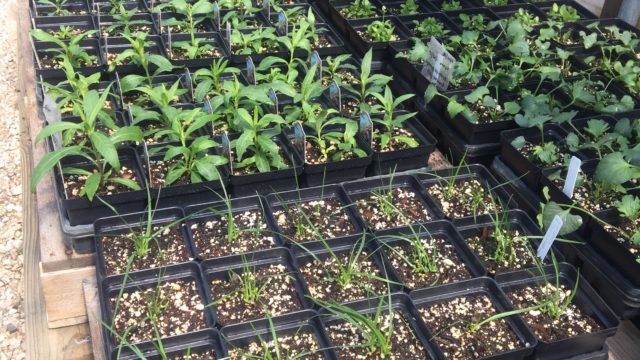In addition to growing straight native perennials, shrubs, and trees, we also offer “nativars” – native plants selected for their smaller size or other small urban garden-appropriate habit while maintaining their environmental value and low-maintenance local adaptability. Our feeling is that it’s better to grow a native plant that has been selected and grown as a genetically identical clone of the parent to fit smaller-sized space or lower height for traffic visibility when necessary than to grow an entirely non-native plant.
NOTE: While the term “nativar” can be used to label native plants that have been hybridized by plant breeders, we do not include them in this group. For our purposes we identify and label straight native plants separately from nativars to distinguish those native selections which are naturally occurring. All other plants are grouped together as hybrids or non-native plants (i.e. we do not include plants from the series Baptisia ‘Decadence’ under our “nativar” label because, although the parent plants are natives, these descendants were manipulated by plant breeders.)
In a Fine Gardening article titled “Are Nativars OK?” by Keith Nevison, the author speaks to observations that show there is variety in preference by pollinators as a result of such things as selections that are more floriferous than the species providing more nectar opportunity. In some cases the straight species is better, but might not be possible to grow due to size, for example, making the choice of a less useful native selection better than a non-native choice.
Keep the following information from the article in mind when selecting plants:
Double flowers
Physical changes in flower anatomy may restrict access to pollen and/or nectar for feeding.
Flower size
A wider corolla may increase dilution of nectar; a smaller corolla may concentrate nectar-enhancing rewards for pollinators.
Flower color
Different colors may alter cues associated with pollinator attraction.
Plant stature
Pollinators may prefer feeding higher or lower as a means of protection from predators.
Foliage color
This is probably benign for pollinators but not for insects who might feed on the foliage.
Bloom time
Many cultivars bloom earlier/later/longer. This can be good, or it can mess with the timing of when the pollinators need that plant. One of the biggest values of native cultivars is that they potentially extend the window of nectar/pollen benefits to wildlife.
Compact habit
This is unknown. It could be that some pollinators preferentially feed closer to the ground to avoid detection by birds and other predators. The opposite could be true too (e.g., Phlox ‘Jeana’ is supertall, and lots of pollinators feed on it). More study is needed on this topic to confirm.
Citizen science like the Nativars Research Project is one way data is being collected on the question of how best to support pollinators in our urban gardens. Click the link to learn more about how you can contribute!

Good morning,
I am an urban bee keeper enthusiast and want to use an area between the street edge of sidewalk to curb as an area of native honey bee/pollinator native plants for both early summer, summer, and fall blooming plants. Currently I am reading up on plants to grow on a perennial basis with minimal care with the exception of thinning for both aesthetically pleasing and nurturing the growth of bees. I live in Manhattan, Kansas and about 300 sqft of area available. I have tried seeds and have not had much success. Would you please provide a list of native, perennial cultivar plants for honey bees/pollinators?
Regards,
Ken Ross
Hi Ken! We have a couple of filters set up so that you can search our plant lists for these specific plants This link should take you to the main butterfly/pollinator native plant listing. I hope this helps! http://vinlandvalleynursery.com/plants/plant_type/perennial/plant_traits/attracts-butterflies-and-pollinators/